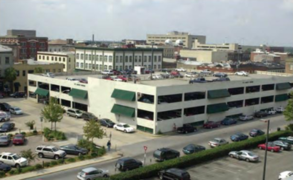
Post Office Square in Boston, Massachusetts is a square located in the financial district at the intersection of Milk, Congress, Pearl and Water Streets. It was named in 1874 after the United States Post Office and Sub-Treasury which fronted it, now replaced by the John W. McCormack Post Office and Courthouse.
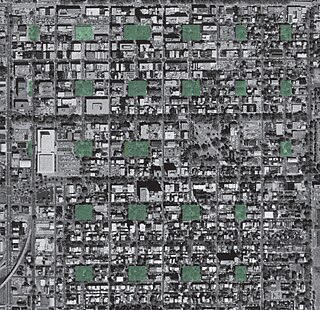
The city of Savannah, Province of Georgia, was laid out in 1733, in what was colonial America, around four open squares, each surrounded by four residential ("tything") blocks and four civic ("trust") blocks. The layout of a square and eight surrounding blocks was known as a "ward." The original plan was part of a larger regional plan that included gardens, farms, and "out-lying villages." Once the four wards were developed in the mid-1730s, two additional wards were laid. Oglethorpe's agrarian balance was abandoned after the Georgia Trustee period. Additional squares were added during the late 18th and 19th centuries, and by 1851 there were 24 squares in the city. In the 20th century, three of the squares were demolished or altered beyond recognition, leaving 21. In 2010, one of the three "lost" squares, Ellis, was reclaimed, bringing the total to today's 22.

The urban development patterns of Lexington, Kentucky, confined within an urban growth boundary that protects its famed horse farms, include greenbelts and expanses of land between it and the surrounding towns. This has been done to preserve the region's horse farms and the unique Bluegrass landscape, which bring millions of dollars to the city through the horse industry and tourism. Urban growth is also tightly restricted in the adjacent counties, with the exception of Jessamine County, with development only allowed inside existing city limits. In order to prevent rural subdivisions and large homes on expansive lots from consuming the Bluegrass landscape, Fayette and all surrounding counties have minimum lot size requirements, which range from 10 acres (40,000 m2) in Jessamine to fifty in Fayette.

Abercorn Common is a 180,000-square-foot (17,000 m2) shopping center in Savannah, Georgia. The center was the first retail center in the U.S. to become LEED-certified, meaning its design incorporates efficiency with attractive buildings and public spaces. The buildings and public spaces resemble Savannah's downtown historic district, with awnings, brick facades, fountains and brick-paved sidewalks. Palm trees, pampas grasses and willow trees are among the natural features. The shopping center dates back to the 1960s, when Abercorn Street was extended to form Abercorn Expressway. At the time, it was one of the first establishments on Savannah's southside, and now it forms the primary shopping corridor of Savannah. Located within several hundred feet are other major shopping centers, including: Oglethorpe Mall, Oglethorpe Plaza anchored by Best Buy and Kohl's, and Chatham Plaza anchored by World Market and Ross Dress For Less.

One Lincoln Street, also known as State Street Financial Center, is a skyscraper in Boston, Massachusetts on the edge of both the Financial District and neighborhood of Chinatown. Completed in 2003, it was built using Boston Redevelopment Authority (BRA) guidelines. Standing at 503 feet tall, One Lincoln Street is the 17th-tallest building in Boston. The skyscraper has a five-level underground garage that provides parking for 900 cars. It contains 1 million square feet of office space.

St. Lawrence Market is a major public market in Toronto, Ontario, Canada. It is located along Front Street East and Jarvis Street in the St. Lawrence neighbourhood of downtown Toronto. The public market is made up of two sites adjacent to one another west of Jarvis Street, St. Lawrence Market North, and St. Lawrence Market South. St. Lawrence Market South is situated south of Front Street East, and is bounded by The Esplanade to the south. St. Lawrence Market North is situated north of Front Street East, and is bounded by St. Lawrence Hall to the north.

O Street Market, also known as Northern Market, is a historic structure located at 1400 7th Street NW in the Shaw neighborhood of Washington, D.C. Built in 1881, it is one of three 19th-century public market buildings still standing in the city, along with Eastern Market and Georgetown Market. The market was listed on the District of Columbia Inventory of Historic Sites in 1968 and the National Register of Historic Places in 1995. The most distinctive architectural element of the Gothic Revival building is its corner tower on 7th and O Streets.

The Savannah Theatre, first opened in 1818 and located on Bull Street, at Chippewa Square, in Savannah, Georgia, is one of the United States' oldest continually operating theatres. The structure has been both a live performance venue and a movie theater. Since 2002, the theatre has hosted regular performances of a variety of shows, primarily music revues.
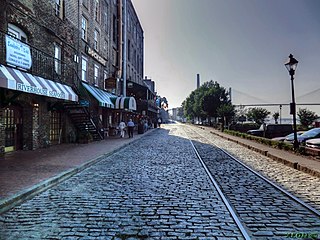
River Street is a commercial street and promenade in Savannah, Georgia, United States. It runs along the southern edge of the Savannah River for 2 miles (3.2 km), from the merging of North and East Lathrop Avenues in the west to East Bay Street in the east. Its most well-known section runs from the Talmadge Memorial Bridge, then below City Hall and Yamacraw Bluff, to its eastern terminus. It is West River Street up to where the Hyatt Regency Savannah spans it. It is here, around 40 feet (12 m) below Bay Street, that it becomes East River Street. The street is one-way (westbound) from Martin Luther King Jr. Boulevard.

Historic Savannah Foundation (HSF) is a preservation organization founded in 1955 and based in Savannah, Georgia, United States.

Ellis Square is one of the 22 squares of Savannah, Georgia, United States. It is located in the northernmost row of the city's five rows of squares, on Barnard Street and West St. Julian Street, and was one of the first four squares laid out. Today, it marks the western end of City Market. The square is east of Franklin Square, west of Johnson Square and north of Telfair Square. The oldest building on the square is the Thomas Gibbons Range, at 102–116 West Congress Street, which dates to 1820.

Madison Square is one of the 22 squares of Savannah, Georgia, United States. It is located in the fourth row of the city's five rows of squares, on Bull Street and Macon Street, and was laid out in 1837. It is south of Chippewa Square, west of Lafayette Square, north of Monterey Square and east of Pulaski Square. The square is named for James Madison, fourth president of the United States. The oldest building on the square is the Sorrel–Weed House, at 6 West Harris Street, which dates to 1840.

Anna Habersham Hunter was an American preservationist, and a founder of the Historic Savannah Foundation in 1955.

Sholl & Fay was the architectural firm of Charles Sholl and Calvin Fay which was active in the 19th century. The partnership existed between 1852 and 1857. They were responsible for the renovations of the City Exchange, Savannah Medical College and several Italianate buildings in Savannah, Georgia, where they were based.
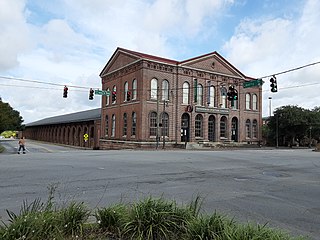
Carl August Schwaab, commonly known as Augustus Schwaab, was a German-American architect and civil engineer. He was principally a designer of commercial architecture, best known for his work in the U.S. state of Georgia, mainly in Savannah, where he worked for around fifty years.
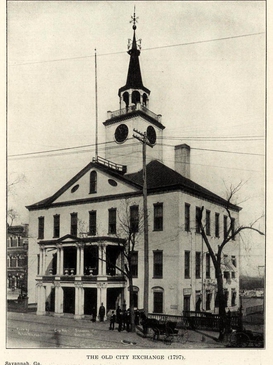
City Exchange was a building that stood on Bay Street in Savannah, Georgia, United States, between 1799 and 1904. It replaced a previous structure which was destroyed by fire in 1796. The former seat of Savannah's city government, the building's location is now occupied by Savannah City Hall.
Moses Ferst was a German-American businessman based in Savannah, Georgia, where he was a merchant and a noted citizen. A stained-glass window in Savannah's Congregation Mickve Israel, one of the oldest synagogues in the United States, was made and installed in his honour.
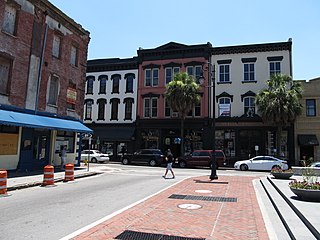
Congress Street is a prominent street in Savannah, Georgia, United States. Located between Bryan Street to the north and Broughton Street to the south, it runs for about 0.76 miles (1.22 km) from Martin Luther King Jr. Boulevard in the west, through the city's City Market, to East Broad Street in the east. Originally known only as Congress Street singular, its addresses are now split between "West Congress Street" and "East Congress Street", the transition occurring at Bull Street in the center of the downtown area. The street is entirely within Savannah Historic District, a National Historic Landmark District.
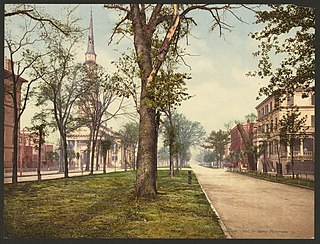
Oglethorpe Avenue is a prominent street in Savannah, Georgia, United States. Located, in its downtown section, between York Street to the north and Hull Street to the south, it runs for about 1.26 miles (2.03 km) from the Atlantic Coastal Highway in the west to Randolph Street in the east. It was originally known as South Broad Street, then Market Street. After being named South Broad Street again for a period, it became known as Oglethorpe Avenue in 1897. It was formerly Oglethorpe Avenue singular, but its addresses are now split between "West Oglethorpe Avenue" and "East Oglethorpe Avenue", the transition occurring at Bull Street in the center of the downtown area. The street is named for the founder of the Savannah colony, James Edward Oglethorpe.
William Richard Waring was a 19th-century American physician. He was described as one of the "most illustrious physicians" in Savannah, Georgia. The William Waring Property, the oldest extant building in that city's Wright Square, is now named for him.


